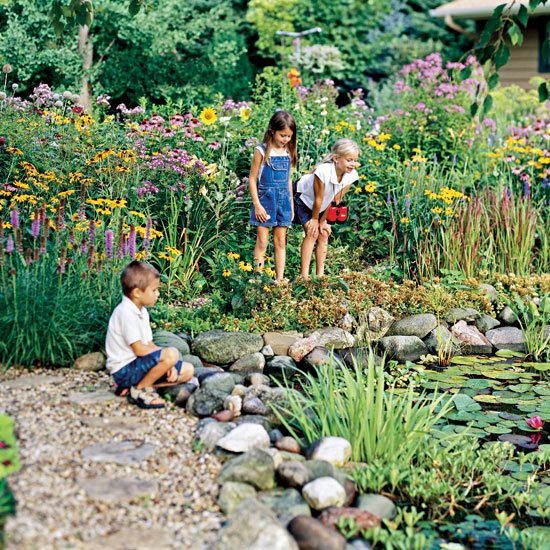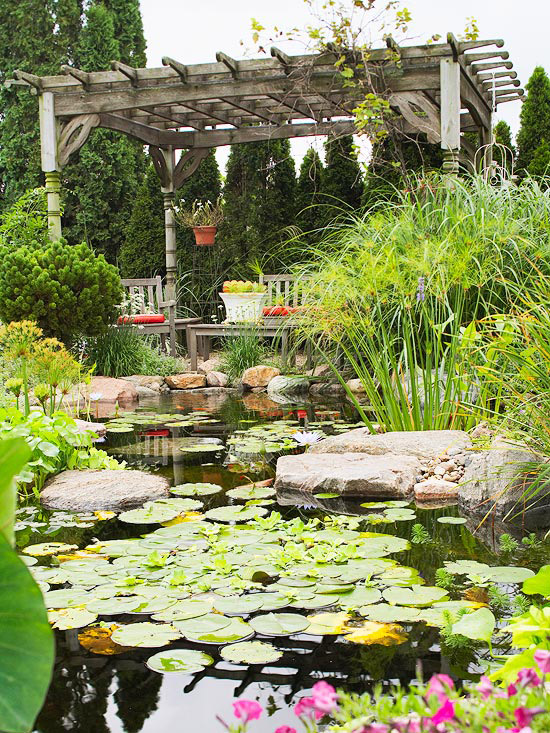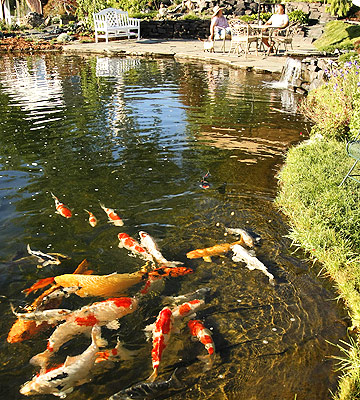Landscape Pond Elements

It's important to learn how to maintain your landscape pond no matter whether it's large or small, in-ground or aboveground. In addition to plants, the materials from which a pond is constructed influence the maintenance requirements of a landscape pond. Here are some basic elements of a landscape pond.
- A liner made of flexible synthetic rubber or PVC sheeting or of rigid plastic or fiberglass. This liner contains the water and prevents leaks.
- A bed of sand. This provides the resting spot for the liner; less common materials include clay or concrete.
- Edging materials, typically stones or concrete pavers. Edging also prevents surface water from draining into the pond, which can cause contamination.
Create a dream water garden.
continue reading below
Landscape Pond Maintenance Routines
It seems counterintuitive, but there can be fewer steps to maintaining a large landscape pond than a small one. Smaller ponds are more prone to fluctuation in ecology and chemistry. However, all ponds need weekly maintenance, with more work at the beginning and end of the growing season in cold-weather climates. Here's how to maintain a landscape pond from season to season.
Build your own outdoor water feature with our how-to.
How to Maintain a Landscape Pond in Spring

- Clean the pond bottom, if needed, by draining the pond and hosing down the liner; more than an inch of muck is detrimental.
- Locate and patch leaks using a pond repair kit. Any landscape pond maintenance routine must include this process, which will prevent ongoing water loss.
- Reinstall the pump and filter; replace if necessary.
- Top off the water level by trickling water at the bottom of the pond to avoid buildup of salts and minerals.
- Skim leaves and debris to help prevent toxic gases.
- Add oxygenating aquatic bunch plants to increase the water's oxygen level.
- Divide potted plants to keep them growing vigorously.
- Begin feeding fish using a high-carbohydrate food to help them with increased activity.
- Move frost-sensitive tropical plants from winter storage. Return them to ponds in the spring after the threat of cold weather has passed.
- Divide and replant water lilies, lotus, and marsh plants.
- Add new floating and submerged plants once the water has warmed to 50 degrees F and all danger of frost has passed; this will keep algae in check.
- Fertilize potted plants.
Choose plants for your pond.
Learn to care for pond plants.
How to Maintain a Landscape Pond in Summer

- Top the water level as needed. It is essential to keep the proper water balance and prevent salt and mineral buildup. When water is needed, add large amounts rarely and small amounts often.
- Test the water chemistry weekly using a kit for ammonia, chloramines, and chlorine. An excessive amount of these chemicals will kill fish.
- Trim plants, removing dead leaves, flowers, and overgrown plants as needed. This will prevent fast growers and plant debris from overwhelming the pond. Remove any submerged plants that appear to be dying.
- Check filters and pump intakes weekly for clogs; clean as needed.
- Add a fountain or bubbler to increase aeration for fish; hot water can be oxygen-depleted.
- Routinely check fish for sores or unusual behavior.
- Control any plant pests as needed to maintain healthy plants; control algae with a long-handle bristle brush, rake, or pole.
- Fertilize potted plants monthly with aquatic-plant fertilizer tablets.
Learn more about landscape pond fish.
How to Maintain a Landscape Pond in Fall
- Skim or net falling leaves; if many trees surround the pond, netting can help catch the leaves. Secure the netting with bricks or rocks.
- Reduce fish feeding and stop completely when the water temperature decreases to 50 degrees F. The reason? Digestion in fish slows in the winter, and undigested food in their guts can kill fish.
- Remove nonhardy plants and fish indoors to ensure winter survival. If your pond does not freeze solid, move hardy submerged plants and hardy water lilies and lotus to the deepest part of the pond after trimming off the foliage.
- Disconnect the filter and pumps; drain and store inside.
- Drain water lines and fountains; use a siphon if necessary.
How to Maintain a Landscape Pond in Winter
- Float wood or a ball on the pond surface to absorb pressure from expanding ice and protect the pond.
- Keep an air hole open for fish with a bubbler or air stone to keep the water moving slowly; this will release toxic gases and prevent the water from freezing.
Get ideas for landscape ponds.








